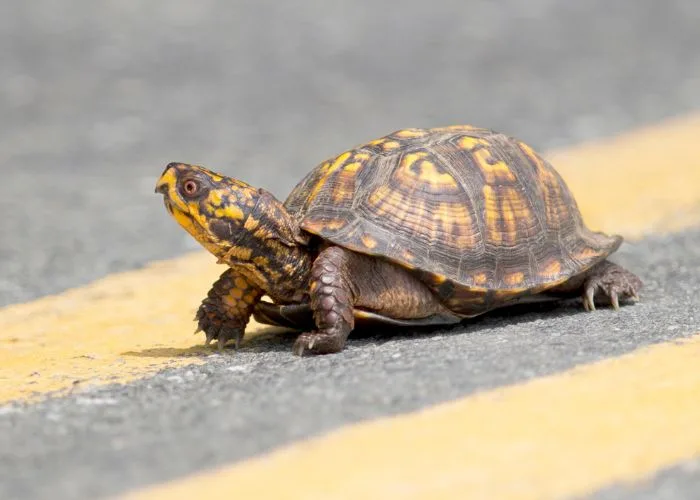Why Did the Turtle Cross the Road? Dos & Don’ts for Migration Season

Turtle migration season is upon us! This means you might see these native and wild amphibians in some unexpected places. Knowing how to interact with turtles making their treks is important for them, as well as all the other species living in connection with them, here in the Lehigh River watershed.
Here are some helpful dos and don’ts:
Relocating: NO
Turtles, especially Eastern box turtles are identified by their yellow, orange, or red streaks around their shell, spend their whole life within the vicinity of a few acres. Their internal compass makes them stay put, and it is advised to keep them in the area you found them. If relocated, turtles can spend the rest of their lives trying to get home. This removes them from familiar surroundings, making them vulnerable and greatly susceptible to dangers like vehicle collisions and predators.
Road crossing: YES, if…
In most instances, it’s best to leave turtles where you find them, but road crossings present an exception, where human intervention could be helpful.
If you see a turtle crossing a road, you can expedite the process and keep it safe from traveling vehicles. When helping a turtle cross the road, do good by making sure to move it in the direction it is headed. Otherwise, the turtle will try to cross the road again to get to its intended destination.
Tools like sticks, buckets, and shovels can be used to move snapping turtles, Pennsylvania’s largest turtle, safely. If picking them up, grab a hold of the shell near their hind legs.
Feeding: NO
It might be tempting to offer the new-found turtle food or water, but non-domesticated wildlife should never be fed by humans.
Injured wildlife: NO, but…
If you encounter an injured turtle, some organizations will contact a licensed wildlife rehabilitator to help. Here’s a list of wildlife resources to keep handy and share.
It is helpful to record the location where you found the injured turtle. This gives it it a greater chance of survival after rehabilitation and release.
– Closest to the Lehigh Valley, Carbon County Environmental Education Center, located in Summit Hill, can assist in wildlife emergencies involving turtles.
– The Poconos Wildlife Rehabilitation Center is a good option for those more north.
Saving turtles? YES
When you support Wildlands, you help protect land. A lot of that land contains critical wildlife habitat. Land protection is one of the most effective (and permanent!) ways we can help care for our native turtle populations. Wildlands has permanently protected more than 60,000 acres since 1973. These arces mean wildlife like turtles, fish, and birds, have a place to call home.
Oh yeah, so why did the turtle cross the road?
Contrary to popular belief, the answer to the nature-take on this joke is not to look for water. Not all turtles are riverine or river-dwelling.
Female turtles travel the latter weeks of May and early June in search of a warm, sunny, and sandy place to lay their eggs. They can take up to a decade to reach the age of maturity to reproduce.
RELATED POSTS
-
Why Did the Turtle Cross the Road? Dos & Don’ts for Migration SeasonTurtle migration season is upon us! This means you might see these native and wild amphibians in some unexpected places. Knowing how to interact with turtles making their treks is important for them, as well as all the other species living in connection with them, here in the Lehigh River watershed. Here are some helpful […]
-
Catching Up on the Career Path: Dwight and SarahOne-time environmental educators Sarah Kovalchick and Dwight Holloway are pursuing their lifelong passions to work in the great outdoors. We caught up with them on their conservation career paths and learned how Wildlands helped prepare them for their present roles. Sarah is living her park-ranger dreams, thanks to her experience with Wildlands! From Wildlands […]